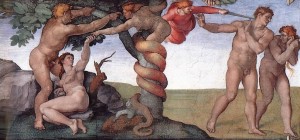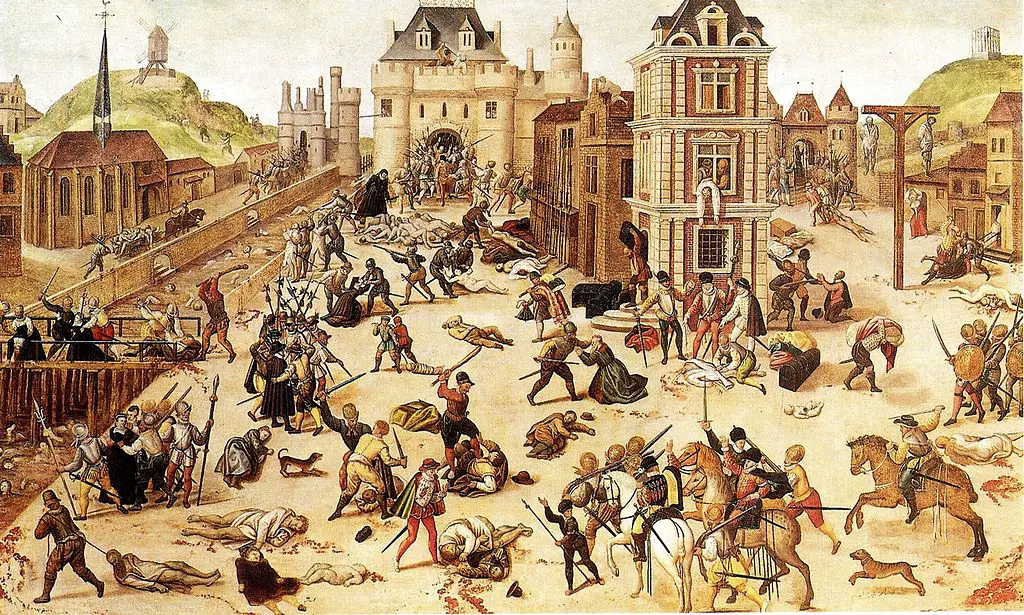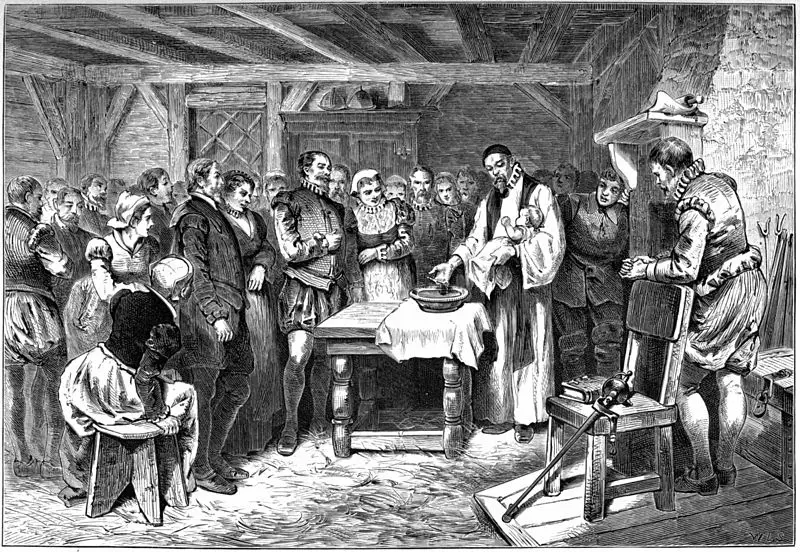The church played a major role in sex and the duties of the female body. The Virgin Mary and Eve, the mother of mankind, helped to develop people's views of sexual intercourse, birth and the formation and function of the female body. Messages were conveyed not only through sermons but also through images and paintings. The act of intercourse, was tainted by the fall of Eve. Women were seen as inferior versions of men and were thought to be greatly susceptible to the devil and the dark forces. The Church taught that women's bodies ran hot and thus they always desired sex and acts of fornication. Thus marriage and sex within marriage was the only way to control a woman's desires. Sex was strictly confined to marriage and only for the purpose of reproduction.
It's fascinating to look at all the rules and laws surrounding when couples could and could not have sex during the Tudor period. They were forbidden to have sex during Lent, Advent, Feast Days, Fast Days, Easter Week, Sundays, Wednesdays and Saturdays... Women were also forbidden to have sex when they were menstruating, pregnant, for the forty day period after giving birth or when they were breast feeding. This clearly did not leave many days during the year when a couple could take part in sex! In addition to this, most women only ovulate once a month so the actual time-frame that a woman could get pregnant was extremely limited. However, many people followed their own natural urges and desires rather than the laws of the church.
The act of sexual intercourse within marriage was to be done only in the missionary style and there was no room or allowance for experimentation. The Church also taught that the missionary position was the best way to conceive a male child and other positions could lead to creating a deformed child. The Church believed that both men and women needed to produce seed to create a child, therefore it was necessary that a woman obtained an org*sm. Which one can suppose was at least a plus side for a Tudor woman!
Although the accepted age for marriage during the Tudor period was around twelve years for girls and fourteen years of age for boys, most believed that twelve was far too young for a girl to be participating in sex. Thus many young married couples were ordered to wait to have sex until the girl was around fourteen to sixteen years of age. An example of where this did not happen was with Margaret Beaufort, mother of King Henry VII. She was married at just twelve years of age to Edmund Tudor, then twenty four. Edmund did not wait to consummate the marriage and shortly afterwards Margaret became pregnant. She gave birth before she was even thirteen years old. It is believed that due to her young age and slender frame the birth had a dramatic and lasting effect upon her body and despite marrying twice more she never conceived another child. Although this is one example where a girl was married at the very earliest age it did not always happen. We often think of people in the Tudor age as marrying in their early teens but many men and women waited until their late teens or even their twenties to be married.
Although the laws of the Church dictated that sex was only to be within the confines of marriage couples clearly broke these rules. An example of this is Anne Vavasour one of Queen Elizabeth I's maids. Anne gave birth to a baby boy in the maids' dormitory at Whitehall Palace at only 16 years of age. The father of the child was the Earl of Oxford who at the time was married to Anne Cecil, daughter of Lord William Cecil, the Queen's most trusted adviser. For their crime, both Anne and the Earl of Oxford were thrown into the Tower of London for a period of time.
For other young couples caught participating in sex outside of marriage the punishment could have been quite severe. In some cases men and women were excommunicated from the Church, but more commonly they were taken to a public place, stripped naked to the waist and flogged.
Why then if couples were engaging in sex outside of marriage did they not use birth control? The simple answer is that birth control during the Tudor period was illegal. The Church dictated that sexual relations were to be undertaken only in marriage and only for procreation and not pleasure. Therefore women and men would not need birth control.
There is a clear contradiction in the Church's beliefs about sex as it appears to have been perfectly acceptable for men, such as King Henry VIII, a married man, to take mistresses and have sex for both pleasure and company. In fact, it was commonly believed that sex during pregnancy could in some way harm or damage the unborn child and thus was frowned upon. And the Church also believed that abstinence within marriage was bad for the health, yet if a man could not have sex with his wife when she was pregnant and he could not sustain from sex due to the effects on his body, clearly he had to look for sex somewhere else. Interestingly, the Church did not comment upon such contradictions in their teaching. When Henry VIII's wives were pregnant he would often take a mistress and the Church turned a blind eye to these happenings.
Although it was illegal, contraception in the Tudor period did exist. It consisted of many varied and different methods including the man withdrawing from the woman before he ejaculated,and the taking of herbs and oils such as oil of mint, oil of rue, oil of savin and honeysuckles juice. The woman could also insert various things into her v*gina, such as pepper, wool soaked in vinegar, or bundles of herbs which would hopefully kill the sperm. A woman might also insert beeswax to cover the entrance to the cervix. The man could also use a type of condom made of lambskin, which was known as a ‘Venus Glove’. Katherine Howard, Henry VIII's fifth wife, is quoted as saying that "a woman might meddle with a man and yet conceive no child unless she would herself".
A child born outside of a legal marriage carried the stigma of being illegitimate. Although the child could be made legitimate through legalization and marriage, there would always be the issue of his or her birth outside of marriage. Sometimes women even went to the Church or to court to try and prove who the father of their child was in an effort to gain support. Tragically, sometimes illegitimate children were given up and raised by the Church so that the woman would not have to carry the social stigma with her for the rest of her life.
If everyone had followed the strict rules of the Church then there would have been no cases of illegitimate children being born and the general population of England would not have continued to grow as it did over the centuries. No matter the period, men and women fell in love and followed their natural desires and urges and engaged in sex.
For more on this, see Claire Ridgway's "Claire Chats" video - Sex, Sexuality and the Female Body in the Medieval and Tudor Period.
Sarah Bryson is the author of Mary Boleyn: In a Nutshell. She is a researcher, writer and educator who has a Bachelor of Early Childhood Education with Honours and currently works with children with disabilities. Sarah is passionate about Tudor history and has a deep interest in Mary Boleyn, Anne Boleyn, the reign of Henry VIII and the people of his court. Visiting England in 2009 furthered her passion and when she returned home she started a website, queentohistory.com, and Facebook page about Tudor history. Sarah lives in Australia, enjoys reading, writing, Tudor costume enactment and wishes to return to England one day.
Sources
- Chapter 6: Sex within Marriage 2014, Tudor Times, viewed 9 July 2015, http://tudortimes.co.uk/daily-life/marriage/sex-within-marriage.
- Kyriazis, S 2014, Sex and sin: 10 Shocking facts about Tudor women, Express, viewed 9 July 2015, http://www.express.co.uk/entertainment/books/478545/Tudor-women-s-lives.
- Licence, Amy, 2011, Naughty Tudors: The historical realities of sex outside marriage, his story, her story, viewed 14 July 2015, http://authorherstorianparent.blogspot.com.au/2011/10/naughty-tudors-historical-realities-of.html.
- Licence, Amy, 2013, Christopher Marlowe's family and the birth of Modern English midwifery in Elizabethan Canterbury, his story, her story, viewed 18 July 2015, http://authorherstorianparent.blogspot.com.au/2013/06/christopher-marlowes-family-and-birth.html.
- Ridgway, Claire, 2009, Tudor Contraception, The Elizabeth Files, viewed 9 July 2015, http://www.elizabethfiles.com/info/tudor-life/tudor-contraception/.




I mentioned this on one of the forum pages. K.H’s statement of being able to meddle with a man, etc, I am wondering whether it’s possible apart from the hope of one of the rudimentary contraceptives working, did K.H use Intercural sex, with Mannox and possibly with Culpepper. I don’t believe K.H and Culpepper had sex in the fullest sence but I feel that they may have indulged in foreplay. I’ve no doubt that K.H and Dereham had sex, but given how full on their relationship was I feel that K.H must have had a secret weapon up her sleeve to prevent pregnancy, or must have been very lucky not to get pregnant. But her marriage with Henry also resulted in no pregnancy too. This may have been down to Henry as I think he was by that time pretty much firing blanks, but there again could K.H been infertile herself? No way of us actually knowing for sure, but it does make for a good debate, and perhaps being able to make a few jokes about Henry’s non working doodle.
i think there’s some exaggeration here. certainly sex before marriage was not that uncommon, many young women were pregnant at the time of marriage, since bethrothal was looked on as almost as legally binding as marriage.
Anne Vavasour bore a son on March 23, 1581. She was born circa 1560. She was not 16.
It’s not actually known when Anne Vavasour was born. Her biography on Oxford DNB doesn’t give a birthdate, just fl. 1580 meaning that she “flourished”, i.e. was known to be alive and active, from 1580 as that is when she is listed as joining Elizabeth’s bedchamber as a maid of honour. It’s the same with many people of that period, for example Anne Boleyn is put at c. 1501 or c. 1507, we just don’t know their exact birthdates. However, maids of honour did tend to be young, around 15/16 when they first started.